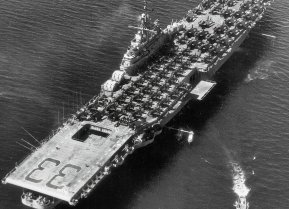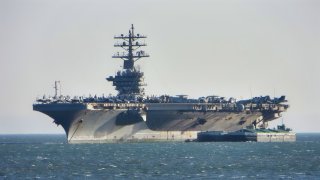Nimitz-Class Aircraft Carrier USS Dwight D. Eisenhower is Unstoppable
The United States Navy's USS Dwight D. Eisenhower (CVN-69) is the second oldest nuclear-powered aircraft carrier in service in the world today. It is currently scheduled to be replaced around 2029 when the new Gerald R. Ford-class supercarrier USS Enterprise (CVN-80) enters service.
Key Point: The United States Navy's USS Dwight D. Eisenhower (CVN-69) is actually the second oldest nuclear-powered aircraft carrier in service in the world today and is currently scheduled to be replaced around 2029 when the new Gerald R. Ford-class supercarrier USS Enterprise (CVN-80) enters service. That is already later than the originally planned 2028 retirement for the CVN-69.
However, last year the U.S. Navy extended the service life of the second oldest Nimitz-class vessel as the Ford-class vessels are running late. The USS Nimitz (CVN-68) is currently on track to be retired in 2026 – and the USS Dwight D. Eisenhower could even remain in service into the early 2030s.
Mark Cancian, a retired Marine colonel now a senior adviser with the Center for Strategic and International Studies in Washington, D.C., told Stars & Stripes on Thursday that keeping the USS Dwight D. Eisenhower beyond the original timeline for its retirement gives the Navy flexibility.
"It would help avoid that gap between when you plan on retiring the Eisenhower and when the Kennedy and other Ford-class carriers are ready to deploy," he explained, adding, "There is tension if you retire carriers on time and there are delays with replacements. You could end up with 10 carriers instead of 11 or 12. To be fair to the Navy, the president is always going to call on them to go anywhere in the world."
That point was made clear last October when President Joe Biden ordered the Eisenhower to the Middle East to support the USS Gerald R. Ford (CVN-78) following the Hamas terrorist attacks on Israel. Since last fall, CVN-69 has been in the Red Sea – joined by the guided-missile cruiser USS Philippine Sea and guided-missile destroyers USS Gravely and USS Mason to stop Houthi missile attacks on shipping. The carrier strike group remains in the U.S. Naval Forces Central Command/U.S. 5th Fleet area of operations to support maritime security and stability in the Middle East region.
Aircraft Carrier Late Arrivals
Extending the older carriers may be necessary as the U.S. Navy's future carriers may be late in arriving. The USS Gerald R. Ford had been originally scheduled for delivery in 2015, only to be pushed back to May 2017. Her first full overseas deployment was only last year – and she is next expected to head to the Puget Sound Naval Shipyard for a $182.2 million electrical upgrade.
Moreover, two other Nimitz-class carriers, the USS George Washington (CVN-73) and USS John C. Stennis (CVN-74) are currently "out-of-service" at Naval Station Norfolk, Norfolk, Virginia – with the former completing her four-year Refueling and Complex Overhaul (RCOH) that began in August 2017. The latter vessel is next up for the scheduled RCOH, which will be completed sometime by the end of the decade.
Be Like Aircraft Carrier Ike
The USS Dwight D. Eisenhower – "Ike" to its crew – is the second of the ten Nimitz-class carriers in service with the Navy today. Named to honor the 34th president of the U.S. and General of the Army, the ship has remained in service for more than four decades.
Congress authorized CVN-69 in 1970, which it later commissioned seven years later. Following more than a year of fleet training, Ike was deployed to the Mediterranean. The mighty shift underwent a major overhaul to be fitted with newer technology in the mid-1980s and was later released back into the waters by 1987.
Over its lengthy service history, the USS Dwight D. Eisenhower has been deployed to a litany of combat operations. The ship’s first deployment was dubbed Operation Eagle Claw during the 1980 Iran hostage crisis. One of the carrier's most notable deployments took place during Iraq’s invasion of Kuwait in 1990. CVN-69 made history when she became the second nuclear-powered carrier ever to transit the Suez Canal.
Author Experience and Expertise: Peter Suciu
Peter Suciu is a Michigan-based writer. He has contributed to more than four dozen magazines, newspapers, and websites with over 3,200 published pieces over a twenty-year career in journalism. He regularly writes about military hardware, firearms history, cybersecurity, politics, and international affairs. Peter is also a Contributing Writer for Forbes and Clearance Jobs. You can follow him on Twitter: @PeterSuciu. You can email the author: [email protected].


